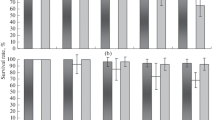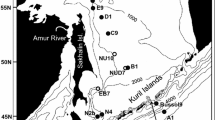Summary
-
1.
The annual cycle of Cyclops strenuus abyssorum Sars in some lakes of the English Lake District is described. Esthwaite Water, Rydal Water and Grasmere, all enriched by sewage, and Buttermere, a relatively unproductive lake, were sampled most frequently.
-
2.
There is only one effective generation in the year in each of these lakes. Individuals of this generation hatch from eggs laid in the spring. In the deepest of the four lakes (Buttermere), these individuals reach the adult stage in early winter, pass the winter in the planktonic zone and start laying eggs early in the following year. In the other three lakes, most individuals of the spring generation reach the fifth copepodid stage by mid-summer and then spend the next eight months in the profundal zone. They leave this zone in February or March to return to the planktonic zone, become adult and start breeding. In July a few individuals may mature in the planktonic zone and give use to a second small generation in the autumn.
-
3.
A correlation between the time in mid-summer when stage V copepodids appear in the profundal zone of the three shallower lakes and amounts of dissolved oxygen in this zone is shown. Although a correlation of this kind is plausible, presence of stage V copepodids in a deep, well oxygenated lake (Thirlmere) suggests that a causal connection of this kind is too simple an explanation, and perhaps only coincidental.
-
4.
Rates of development of the different instars were found experimentally at constant temperatures and used to estimate production. Production, biomass and fecundity were all higher in Esthwaite Water than in the other three lakes.
Similar content being viewed by others
References
Brady, G. S.: A revision of the British Species of Fresh-water Cyclopidae and Calanidae. Trans. nat. Hist. Soc. Northumb. 11, 1–55 (1891).
Burgis, M. J.: The ecology and production of copepods, particularly Thermocyclops hyalinus, in the tropical Lake George, Uganda. Freshwat. Biol. 1, 169–192 (1971).
Colebrook, J. M.: The seasonal life-cycles of some of the planktonic Crustacea of Windermere. MSS in library of the Freshwater Biological Association (1956).
Collins, V. G.: Isolation, cultivation and maintenance of autotrophs. In: Methods in microbiology, Ed. Norris J. R. and Ribbons, D. W., 3B, 1–52. London: Academic Press 1969.
Corkett, C. J., McLaren, I. A.: Relationships between development rate of eggs and older stages of copepods. J. mar. biol. Ass. U.K. 50, 161–168 (1970).
Cummins, K. W., Costa, R. R., Rowe, E. R., Moshiri G. A., Scanlon, R. M., Zajdel, R. K.: Ecological energetics of a natural population of the predaceous zooplankter Leptodora kindti Focke (Cladocera). Oikos 20, 189–223 (1969).
Dussart, B.: Les Copépodes des eaux continentales d'Europe occidentale Tome 2. Cyclopoides et biologie 1–292. Paris: Boubee 1969.
Einsle, U.: Die Gattung Cyclops s. str. im Bodensee. Arch. Hydrobiol. 60, 2, 133–199 (1964).
Einsle, U.: Populationsdynamische und synökologische Studien am Crustaceen-Plankton zweier Kleinseen. Beitr. naturk. Forsch. Südw-Dtl. 28, 53–73 (1969).
Elbourn, C. A.: The life-cycle of Cyclops strenuus strenuus Fischer in a small pond. J. Anim. Ecol. 35, 333–347 (1966 a).
Elbourn, C. A.: Some observations on the food of Cyclops strenuus strenuus (Fischer). Ann. Mag. nat. Hist. 9, 227–231 (1966 b).
Elgmork, K.: Seasonal occurrence of Cyclops strenuus strenuus in relation to environment in small water bodies in southern Norway. Folia limnol. scand. 11, 1–196 (1959).
Elgmork, K.: Ecological aspects of diapause in copepods. Proc. Symp. Crust. 3, 947–954 (1967).
Fryer, G.: Contributions to our knowledge of the biology and systematics of the freshwater Copepoda. Schweiz. Z. Hydrol. 16, 64–77 (1954).
Gurney, R.: The crustacean plankton of the English Lake District. J. Linn. Soc. 35, 411–447 (1923).
Gurney, R.: British Freshwater Copepoda, Vol. III. London: Ray Soc. 1933.
Hillbricht-Ilkowska, A., Patalas, K.: Methods of estimating production and biomass and some problems of quantitative calculation methods of zooplankton. Ekol. Polsk. B. 13, 139–172 (1967).
Klekowski, R. Z., Shushkina, E. A.: The energetic balance of Macrocyclops albidus (Jur.) during the period of its development. In ecology of aquatic organisms. Akad. Nauk SSSR. uses. gidrobiol. Obshch. Moskva. 125–136 (1966).
Lindberg K.: Liste des Cyclopoides gnathostomes (Crustacés copépodes) des îles Brittanniques et de l'Irlande. Hydrobiologia. 2, 301–312 (1950).
Lowndes, A. G.: The density of some living aquatic organisms. Proc. Limn. Soc. Lond. 150, 62–73 (1938).
McLaren, I. A., Corkett, C. J., Zillioux, E. J.: Temperature adaptations of copepod eggs from the arctic to the tropics. Biol. Bull. 137, 486–493 (1969).
Petrovich, P. G., Shushkina, E. A., Pechen, G. A.: Evaluating zooplankton production. Dokl. Akad. Nauk. SSSR. 139, 1235–1238 (1961).
Rodhe, W.: Zur Verbesserung der quantitativen Planktonmethodik nebst Profilen des Crustaceenplanktons aus drei smalandischen Seen. Zool. Bidr. Uppsala. 20, 465–477 (1941).
Røen, U.: Contributions to the biology of some Danish free-living freshwater copepods. Biol. Skr. Dan. Vid. Selsk. 9, 1–101 (1957).
Smyly, W. J. P.: Observations on the planktonic and profundal Crustacea of the English Lake District. J. Anim. Ecol. 37, 693–708 (1968).
Spindler, K. D.: Die Bedeutung der Photoperiode für die Entwicklung von Cyclops vicinus. Zool. Anz., Suppl. 33, 190–195 (1969).
Watson, N. H. F., Smallman, B. N.: The role of photoperiod and temperature in the induction and termination of an arrested development in two species of freshwater cyclopid copepods. Can. J. Zool. 49, 855–862 (1971).
Wierzbicka, M., Kedzierski, S.: On dormancy of some species of Cyclopoida under experimental and natural conditions. Polsk. Arch. Hydrobiol. 12, 47–80 (1964).
Winberg, G. G., Pechen, G. A., Shushkina, E. A.: The production of planktonic crustaceans in three different types of lake. Zool. Zh. 44, 676–688. N.L.L. transl. 6019 (1965).
Author information
Authors and Affiliations
Rights and permissions
About this article
Cite this article
Smyly, W.J.P. Bionomics of Cyclops strenuus abyssorum Sars (Copepoda: Cyclopoida). Oecologia 11, 163–186 (1973). https://doi.org/10.1007/BF00345130
Received:
Issue Date:
DOI: https://doi.org/10.1007/BF00345130




